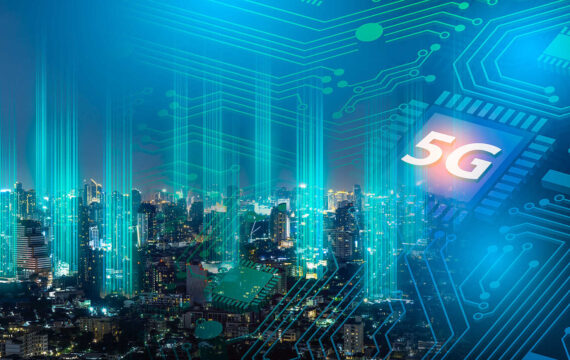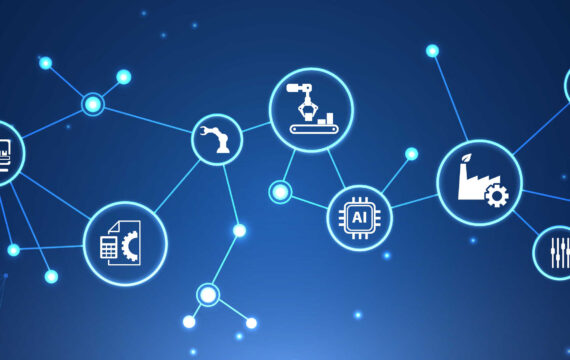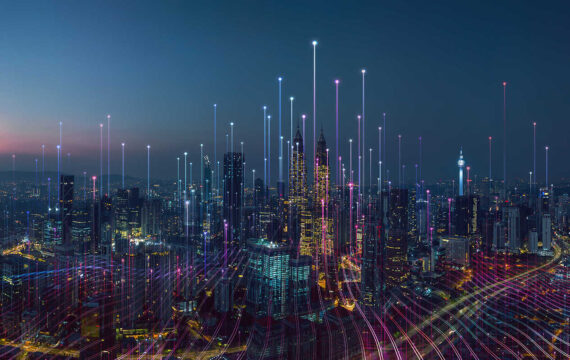Machines are getting smart. This is what we hear over and over again, and it brings to mind the image of Sarah Connor fighting the Terminator or Will Smith battling evil robots. However, unlike in Hollywood blockbusters — which depict a fundamental struggle between humans and machines — in the real world, robots are quite useful and widely applied across different domain. The symbiosis of the Internet of Things (IoT) and artificial intelligence (AI) has given us a new category of robots aimed at making humans work better and faster. And these robots are ushering in the next industrial revolution, powering the era of Industry 5.0.
And what is Industry 5.0?
Heading for Industry 5.0: A brief history of industrial transformation
Over the centuries, the development of new technologies has changed the way people produce things. In the middle ages, the family system reigned. Its key feature was collective production and consumption with a simple division of work between family members. Families at that time were large, and many had slaves. These family units worked together to grow their own food, make their own clothing, and meet other needs with their own resources.
Over time, the family system was replaced by the handicraft system, the main characteristic of which was the specialization of work. People with common professions — such as plumbers, cobblers, and carpenters — formed associations that included a master craftsman and workers specialized in a particular craft. Importantly, craftsmen worked with their own materials and sold the products they made in their own shops. Therefore, they were in direct contact with the market and consumers.
However, as the market expanded and the scale of production increased, a close connection between producers and consumers was no longer possible. This is when intermediaries came into existence, and the handicraft system was succeeded by the domestic system. In this system, workers still used their own tools to fabricate products in their own homes or in workshops attached to their homes, but they neither bought raw materials nor sold finished products. This was done by merchant-employers, who were focused on maximizing profit by trade.
The introduction of water power and steam engine at the end of the 18th century marked the beginning of the factory system, which introduced a new method of manufacturing based on machinery and a concentration of industry into large establishments. But even more importantly, it signified the beginning of what we now call the industrial revolution, which brought completely new methods of production and boosted economic development around the world.
In the early 20th century, water and steam were replaced by electricity, which triggered the second stage of the industrial revolution. The invention of assembly line manufacturing helped rationalize production and eliminate unnecessary and repetitive tasks performed by workers.
The next advance in the factory system and, consequently, the third stage of the industrial revolution was partial automation using memory-programmable controls and computers during the 1970s. This enabled manufacturers to attain greater consistency and quality of goods as well as to significantly increase the speed of production. The logical continuation of this approach was the further automation of workflows, aimed at reducing the need for human intervention to a minimum — or even eliminating it altogether. The application of IoT in industrial automation resulted in what is known as Industry 4.0, also referred to as the Industrial Internet of Things (IIoT).
IIoT allows manufacturers to upgrade existing machinery with smart production equipment as well as get insights from multiple data sources with monitoring and forecasting techniques. Today’s high-tech machines can not only perform more tasks per unit of time but also tell when they’re about to break down and need to be repaired. It looks like this advanced digitalization leaves no room for human workers, doesn’t it? Still, only humans can make machines more intelligent — and this lies at the cornerstone of Industry 5.0.

Industry 5.0 technologies — Mass customization of the customer experience through digital transformation

Source: Furniturk Magazine Online — Ready for Industry 5.0
Lights-out manufacturing: The bright future that lies in darkness
Fears of those with a pessimistic mindset, who believe that automation will replace production workers one day, are not groundless within Industry 5.0. While factories that operate autonomously and require no human supervision may sound like science fiction, they have been a reality for more than 15 years. These kinds of factories are called dark factories, or lights-out factories, as they’re equipped with fully automated systems that can function in the dark.
One real-world example is offered by FANUC, a Japanese robotics company that’s a pioneer in lights-out manufacturing. FANUC has plants where robots build other robots without human supervision. “Not only is it lights-out,” says Gary Zywiol, the FANUC Vice President, “we turn off the air conditioning and heat too.”
Such an approach has a number of advantages: there are no delays, no labor disputes, and no heating or lighting bills. The robots work around the clock, which results in 24/7 uninterrupted production. Several human workers are left to simply ensure that everything runs smoothly.
Factory of the future in Industry 5.0

Source: CB Insights — How Technology Is Transforming Manufacturing
But it would be unfair to say that Industry 4.0 is only about reducing waste while optimizing performance. It’s also about product customization — something that was unimaginable not that long ago. For instance, today’s buyers can design their own cars online with hundreds of different variables — colors, interiors, and lots of other features. In fact, technologies enable customers to get cars that appear one-of-a-kind, while manufacturers can produce them within the mass production system using assembly line techniques.
This approach seems to be a dream for the consumer goods industry. What else could one wish for? But consumers want more. The mass customization enabled by Industry 4.0 is not enough. Consumers seek a truly bespoke experience and products that provide a feeling of human care and craftsmanship — something that conceptually brings us back to the handicraft system but technologically takes the vision of personalization to the next level of Industry 5.0 opportunities and challenges.
Industry 5.0: The revolution of human touch
The growing demand for craftsmanship and personalization of products is not only related to the fact that consumers want to express their identities through the goods they buy. Sometimes, the ability to manufacture a personalized product can literally be life-changing. A good example is the medical devices industry and, specifically, artificial pancreas systems. These systems are issued to patients with Type 1 diabetes who need to follow strict treatment plans and constantly control their blood sugar levels. An artificial pancreas system works as follows: a glucose monitor draws blood and detects the glucose level in it, then talks to another device which delivers insulin through a tube attached to the patient’s skin. Such a service orchestration and automation platform is an one-size-fits-all solution that works, but it would definitely be better to tweak the control system for the individual, as different diabetes patients have different metabolic rates and other body parameters. Moving to Industry 5.0 enables the manufacturers of artificial pancreas systems to give individuals an app that follows their unique lifestyles and applies advanced AI techniques to define how a patient’s body reacts to a particular device. After patterns are defined, they can be fed into the production process to make the artificial pancreas tailor-made for the individual patient.
This is what Industry 5.0 is and what Industry 5.0 technologies offer. The concept of personalization in Industry 5.0 doesn’t mean in any way that consumers won’t accept technology. They’re fine with automation being part of the manufacturing process; however, they crave the personal imprint of human craftspeople, who produce something special through their dedication and effort. This can be achieved by tight collaboration between workers and machines, applying Industry 5.0 technologies and artificial intelligence development. Such business operations automation with RPA strives not to substitute humans but to accelerate their performance. In this way, humans will be able to spend more time on strategizing and planning as well as on other high-value tasks.
To achieve this collaboration in the workspace, Industry 5.0 is using cobots, or collaborative robots. Cobots are applied to optimize the production process and ensure work safety. Ironically, it’s the use of robots that has contributed to bringing the human factor back to manufacturing. According to Mark Beulegue, VP of Global Operations at Rogers, “Industry 5.0 recognizes that man and machine must be interconnected to meet the manufacturing complexity of the future in dealing with increasing customization through an optimized robotized manufacturing process.”
It looks like production workers can finally rest assured that automation won’t replace them. Thanks to cobots, they can continue operating in their roles while doing fewer dirty and dangerous tasks. However, some changes will occur to reflect this new relationship between human and machine. As Myria Research forecasts, the combination of a human and robotic workforce will result in a new executive role of chief robotics officer (CRO), who will be responsible for managing the activities around robotics and intelligent operational systems (RIOS). Amazon, the world’s leading tech innovator, has already taken steps to address this trend and has launched an educational program for their employees to raise the next generation of robotics experts.

The point of no return: Industry 5.0 opportunities and challenges
When it comes to technology, there’s no turning back. Much like the previous four industrial revolutions, the fifth will reshape the industrial paradigm, bringing inevitable changes to the manufacturing sector. While it’s quite clear that humans will remain central to effective automation, they’ll have to learn new skills to meet the demand for growing mechanization and embed creativity into efficient processes. Manufacturers, in turn, will be able to create more than just products; they will be able to deliver something special and unique. As Sir Arthur Charles Clarke so aptly said, “any sufficiently advanced technology is indistinguishable from magic.” And that’s what Industry 5.0 is about.
Reach Intellias experts who are fascinated by new IoT and AI applications and are ready to implement them in your business.




